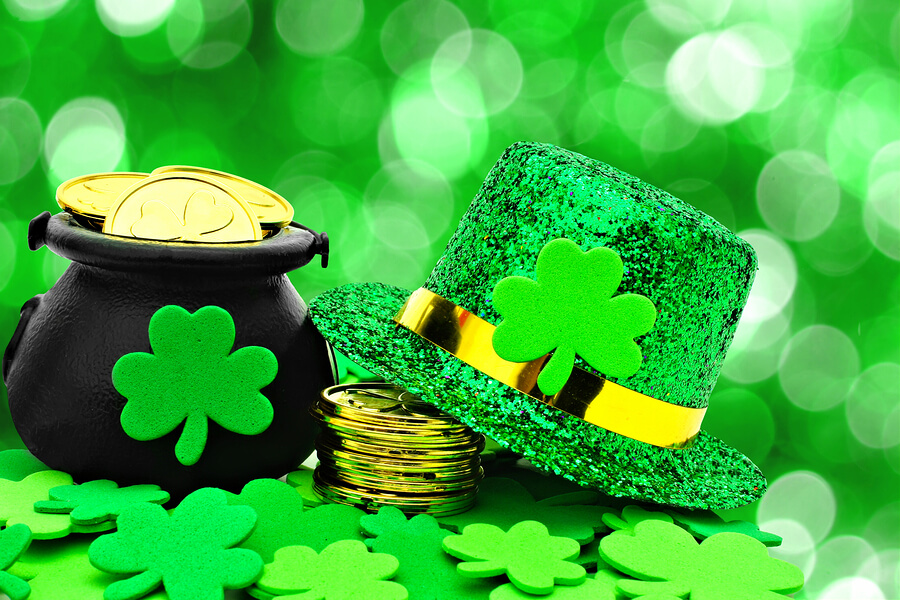St. Patrick’s Day Every year on March 17th, people around the world don their green attire, raise a pint of Guinness, and join in the festivities of St. Patrick’s Day. This annual celebration honors St. Patrick, the patron saint of Ireland, while also serving as a vibrant showcase of Irish culture, heritage, and traditions. Let’s delve into the rich history and customs surrounding St. Patrick’s Day:

Origins and History:
St. Patrick’s Day commemorates the life and legacy of St. Patrick, a missionary and bishop who is credited with bringing Christianity to Ireland in the 5th century. While the exact details of St. Patrick’s life are shrouded in legend, he is celebrated for his efforts to spread the teachings of Christianity and his role in converting the pagan Irish to the faith.
Symbols and Traditions:
St. Patrick’s Day is synonymous with a myriad of symbols and traditions that are deeply rooted in Irish culture. From the iconic shamrock, which is said to have been used by St. Patrick to explain the concept of the Holy Trinity, to the color green, which symbolizes Ireland’s lush landscapes and is worn as a mark of pride and solidarity, these symbols serve as enduring emblems of Irish identity.
Parades and Festivities:
One of the hallmark traditions of St. Patrick’s Day is the vibrant parades that take place in cities and towns around the world. These parades feature elaborate floats, marching bands, traditional Irish music, and dancers clad in colorful costumes, creating a spectacle of joy and merriment for participants and spectators alike. The largest and most famous St. Patrick’s Day parade takes place in Dublin, where thousands gather to celebrate their Irish heritage.
Music and Dance:
Music and dance are integral components of St. Patrick’s Day celebrations, with traditional Irish music echoing through pubs, concert halls, and street corners throughout the day. The lively rhythms of jigs, reels, and folk songs evoke the spirit of Ireland’s rich musical heritage, inspiring people of all ages to join in the revelry with spontaneous dancing and sing-alongs.
Culinary Delights:
St. Patrick’s Day is also a time to indulge in traditional Irish cuisine and culinary delights. From hearty stews and tender lamb dishes to creamy colcannon and crispy soda bread, Irish food is celebrated for its simplicity, freshness, and comfort. Of course, protogel no St. Patrick’s Day celebration would be complete without a pint of Guinness, Ireland’s famous stout, or a sip of Irish whiskey to toast to the occasion.
Global Celebration:
While St. Patrick’s Day originated as a religious feast day in Ireland, it has since evolved into a global celebration of Irish culture and heritage. From New York to Tokyo, cities around the world embrace the spirit of St. Patrick’s Day with parades, festivals, and cultural events that pay homage to the Emerald Isle and its people.
Conclusion:
St. Patrick’s Day is more than just a day of revelry and green beer – it is a celebration of Irish culture, heritage, and tradition that unites people of all backgrounds in a spirit of joy and camaraderie. Whether you’re Irish by birth or Irish at heart, St. Patrick’s Day offers an opportunity to embrace the rich tapestry of Irish identity and to celebrate the enduring legacy of St. Patrick himself. So, don your green attire, raise a toast to Ireland, and join in the festivities of St. Patrick’s Day!
Pros and Cons of St. Patrick’s Day: Balancing Tradition and Celebration
St. Patrick’s Day, observed annually on March 17th, celebrated holiday that honors the patron saint of Ireland, St. Patrick. This festive occasion is marked by parades, parties, and cultural events that showcase Irish heritage and traditions. While St. Patrick’s Day brings joy and camaraderie to millions of people around the world, it also has its share of advantages and disadvantages. Let’s explore both sides of the coin:

Advantages:
- Celebration of Irish Culture: St. Patrick’s Day provides an opportunity to celebrate and promote Irish culture, heritage, and traditions. From traditional music and dance to culinary delights and folklore, the holiday offers a window into the rich tapestry of Irish identity. Fostering appreciation and understanding among people of all backgrounds.
- Sense of Unity and Belonging: St. Patrick’s Day serves as a unifying force. That brings people together in a spirit of joy and camaraderie. Whether you’re Irish by birth or Irish at heart, the holiday offers a sense of belonging and community, as individuals join in the festivities and revel in shared cultural experiences.
- Economic Benefits: St. Patrick’s Day generates significant economic activity through tourism, hospitality, and retail sales. Cities around the world host parades, festivals, and events that attract visitors and stimulate local economies. Additionally, the sale of Irish-themed merchandise, food, and beverages contributes to a boost in consumer spending.
- Cultural Exchange: St. Patrick’s Day promotes cultural exchange and mutual understanding among nations. Through parades, concerts, and other festivities People from diverse backgrounds come together to celebrate Irish culture and heritage. Fostering friendships and connections that transcend borders.
- Promotion of Tourism: St. Patrick’s Day tourists seeking to experience the unique atmosphere and traditions of the holiday. Cities with large Irish populations, such as Dublin, New York, and Boston. See an influx of visitors who flock to witness parades, visit cultural attractions, and immerse themselves in the festive spirit.
Disadvantages:
Commercialization and Stereotyping:
Critics argue that St. Patrick’s Day has become overly commercialized. With an emphasis on green beer, leprechauns, and other stereotypical symbols that may perpetuate caricatures of Irish culture. This commercialization can detract from the true meaning and significance of the holiday, reducing it to a superficial spectacle.

Excessive Drinking and Public Disorder:
St. Patrick’s Day is often associated with excessive drinking and public intoxication. Leading to incidents of disorderly conduct, vandalism, and alcohol-related accidents. The emphasis on alcohol consumption during the holiday can contribute to irresponsible behavior and pose risks to public safety.
Cultural Appropriation:
Some people criticize the appropriation of Irish culture and symbols by individuals and organizations. That have no genuine connection to Ireland. The use of stereotypical imagery, such as shamrocks, leprechauns, and Irish accents. Without understanding their cultural significance, can be seen as disrespectful and offensive.
Environmental Impact:
The large-scale celebrations associated with St. Patrick’s Day. Including parades, fireworks, and outdoor events, can have negative environmental consequences. These activities may result in increased pollution, waste generation, and energy consumption, contributing to environmental degradation and climate change.
Historical and Political Sensitivities:
St. Patrick’s Day can be a source of contention in regions with complex historical. And political dynamics related to Irish identity and nationalism. In some cases, the holiday may be seen as a symbol of colonialism or cultural imperialism. Leading to debates and tensions over its observance.
In conclusion, while St. Patrick’s Day is widely celebrated as a joyous occasion that promotes Irish culture and camaraderie. It also raises important considerations regarding commercialization, public behavior, cultural sensitivity, and environmental impact. By acknowledging these factors and striving for a balance between tradition and celebration. We can ensure that St. Patrick’s Day remains a meaningful and inclusive holiday for generations to come.
Read More Article About “Dragon’s Dogma 2024: Exploring the Epic Fantasy World“



